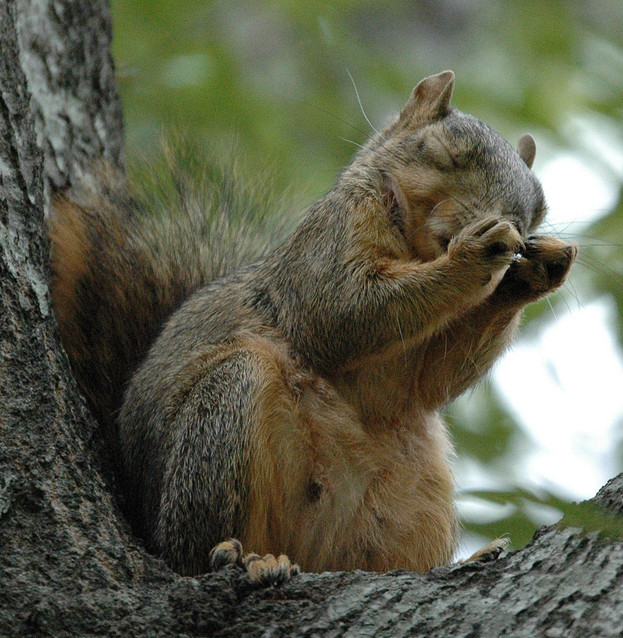
Making an Effort to Co-tend the Earthly Garden with Our Squirrel Friends
Creating an Organic and Non-violent Barrier to Gardening in the Same Place with Allium Plants
I buy half oak wine barrels, stain the outsides, and plant them with herbs and roots,
and then create 5-foot high cylinders that fit from soil-line up. The squirrels will
not dig there, and that's that. Simple but too thoughtful for gardening morons who prefer
killing animals to thinking.
Spraying cayenne around plants can burn a squirrels eyes out or cause them to scratch
their eyes while trying to sooth them. It's cruel and should be avoided. Allium planted
around fruit trees bases or clear plastic bowls (found in catering sections of stores like
Smart'n'Final, can be cut from the edge (with scissors) up to a hole and then
affixed to the base of a tree to prevent climbing. Personally, I love sharing fruit with
animals (and people) who make life worth living.
Creating an Organic Attraction for Squirrels to the Yard with Homes and Feeders in Safe Places
These should be put near the home, at least 7-8 feet above ground to avoid cats and raccoons,
and should be out of line of hawks that perch and hunt in pairs. Try putting the squirrel
near getaways — tree trunks, tree branches, thick brush — as well as having
a tree, composter, or fence block predator perch-point lines-of-sight.
I add wooden homes for the winter so that the wind, sun, and predators cannot get to
my friends. The homes should be at least 30-feet above ground. The best homes have
predator guards built into them, as wel;l as dual entrances, and are large and deep
so that paws cannot get to the family inside. During winter a family can "take in" others
so that as many as 12 squirrels keep each other fed, warm, and safe. Winds can destroy
safe places, and parasites make moving a regular chore. I try to make their lives easier
and longer.
A Red Fox Squirrel could live to 18 years but rarely does so because of humans (esp.
profiteering land developers) encroaching upon food sources, the expansion of predator
bird populations (especially crows and hawks), and the mindless "owning" of cats. The
fashion appeal of owning an animal (or even a child) as a slacker substitution for
owning yourself wears off. The cats are abandoned to a harried "feral" survivalism
by those whose own brains — walking around in human bodies — surely must
be questioned for having any empathy along with having little dream-making courage.
Creating a Cat-safe Yard by Dispersing Rue Plants
Feral cats are a result of human irresponsibility. They kill squirrels, chipmunks,
and songbirds. They kill because they can, and find babies especially killworthy.
Rue plants turn cats away with certainty. Lining your fence-entrance areas with these medicinal,
climate-versatile (5-8), perennial plants gives the nesters a chance for momma and poppa
squirrel to take their babies on running, hopping, scrounging, and other training trips
away from the nest.
Facilitating Cooperation between Squirrel Families
Put a feeder near each home or nest so squirrels do not have to travel across roads (run by idiot teenagers, men/women on cell phones, or men/women late to work). Try to avoid a family having to get its young across dangerous open areas (attackable by predator cats and hawks) because the young ones are so very susceptible when they are small, unsuspecting, untrained, and inexperienced.
Escape Routes
Sides of houses that are surrounded by fencing are traps when a squirrel is confronted with a predator while scrounging for food, training babies, or storing food. I affix knotted thick hemp (or rope from the bottom of the fence to the top, making certain that both ends are attached to the fence so it acts like a stable "ladder" for escape. I also attach platforms that slant up to the top of the fence, which are roughed wood, so that a young one's jump will get them to it and with a scramble, saves them for their lives for loving parents and siblings.